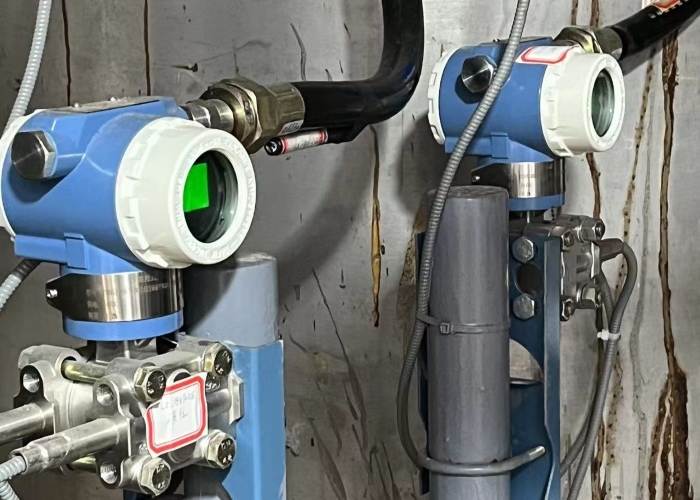
Influencing factors of the measurement accuracy of differential pressure transmitters
2025-07-04 16:20
With the advancement of instrument technology, various brands of differential pressure transmitters are developing towards high precision and intelligence. However, the advancement of technology has brought about a misunderstanding among designers: when choosing differential pressure transmitters, people often focus on the accuracy of the differential pressure transmitters but overlook the factors influencing their measurement accuracy.
1.The influence of range comparison on the measurement accuracy of differential pressure transmitters
The range ratio of a DP transmitter refers to the ratio of the maximum to the minimum value that the transmitter can measure under the condition of meeting the accuracy requirements. Generally speaking, the larger the range ratio, the lower the measurement accuracy. A differential pressure transmitter with a large range ratio has many advantages. After such an instrument is calibrated, it can be used in multiple different occasions. However, in practice, if the range ratio is set too high, it will bring many problems with measurement stability.
For most differential pressure transmitters, within a range ratio of 10:1, the accuracy remains the reference accuracy and is not affected by the range ratio. However, there are still a considerable number of differential pressure transmitters that ensure a range ratio of reference accuracy less than 10:1, and this indicator is even 3:1 and 2:1. Moreover, for the same model of product, different range codes may also result in significant differences in the range ratios that ensure reference accuracy. These are all points that users need to pay special attention to when calculating the accuracy affected by the range ratio.
2. The influence of temperature on the measurement accuracy of DP transmitters
In the process application of differential pressure transmitters, the process temperature and ambient temperature will change significantly, which will definitely be different from the reference conditions during the transmitter test. This also means that the performance will be different from the reference accuracy introduced. The influence of temperature on differential pressure transmitters is very small when approaching the maximum range (i.e., the small range ratio), but it becomes significant when approaching the minimum range (i.e., the large range ratio), sometimes even exceeding our imagination. According to the comprehensive influence formula of temperature on zero-point accuracy and range accuracy provided in some product manuals, if the maximum range ratio input is 100, an influence of nearly 10% can be obtained.
Some modern intelligent differential pressure transmitter products have added internal temperature sensors to correct the thermal effects caused by changes in ambient temperature.
3. The influence of static pressure on the measurement accuracy of differential pressure transmitters
Similar to the influence of temperature and range, static pressure also has a substantial impact on the zero point and range accuracy of differential pressure transmitters. For instance, capacitive differential pressure transmitters are almost always affected by static pressure during the operation of the production process system.
When the static pressure of the operating condition exceeds a certain value, the error caused by the static pressure will exceed the accuracy of the transmitter itself. When calculating the channel accuracy of the measurement channel, if the static pressure influence error is included, the channel accuracy requirements may not be met. Therefore, when calibrating capacitive differential pressure transmitters, the static pressure influence must be corrected.
4. The influence of installation tilt Angle on the measurement accuracy of differential pressure transmitters
The installation tilt Angle refers to the Angle between the central axis of the transmitter and the vertical line after the transmitter is installed on site.
When measuring differential pressure, the detection element senses the pressure difference on both sides by measuring the deformation and displacement of the diaphragm at the detection center. As the central measurement chamber is filled with silicone oil, when the differential pressure transmitter tilts along the plane perpendicular to the measurement diaphragm, the silicone oil itself will exert pressure on the measurement diaphragm, causing deformation of the diaphragm and resulting in changes in the output value.
When the DP transmitter is inclined in a direction parallel to the plane of the measuring diaphragm, the silicone oil filled will not press on the measuring diaphragm, thus having no effect. Transmitters of different ranges are affected by inclination to varying degrees; the smaller the range, the greater the impact. When the differential pressure transmitter tilts forward or backward, the changes in its output linearity and output value are not obvious, which will not affect its normal use. When the differential pressure transmitter tilts to the left or right, its output value will drift in a single direction according to the tilt Angle. The larger the Angle, the greater the impact, but the linearity will not change significantly.
5. The influence of the height difference between the measurement point and the installation point on the measurement accuracy of the differential pressure transmitter
Due to the overall design requirements of the industrial site, DP transmitters are often not installed near the measurement points at the usage site. Instead, they are led to a relatively concentrated location through pressure guiding pipes to facilitate maintenance and management.
This will cause a height difference between the measurement point and the installation point of the differential pressure transmitter. The pressure transmission medium in the pressure guiding pipe will generate additional pressure due to the height difference, thereby having an impact and introducing additional errors. In process industry applications, due to the often high density of the medium, even a small height difference can introduce significant additional errors.
